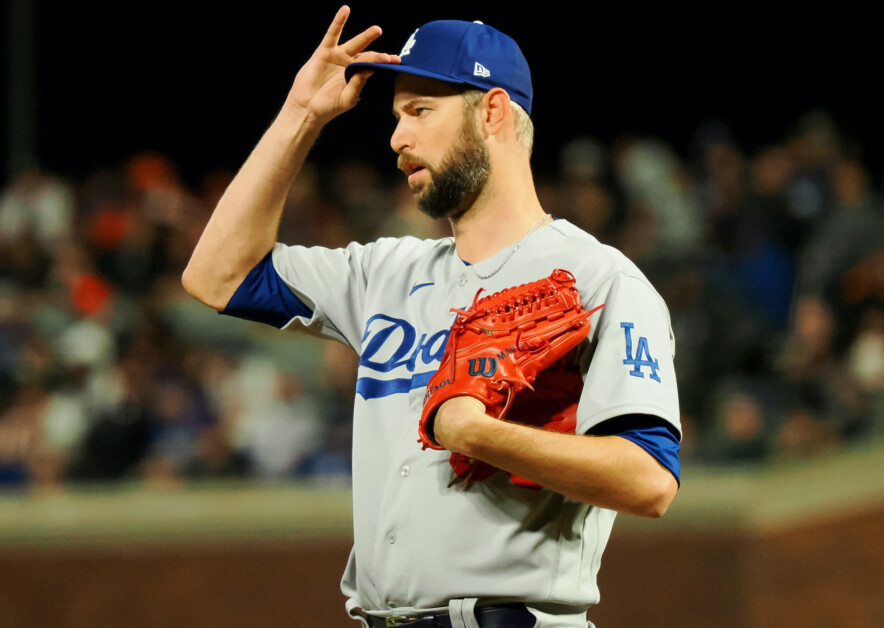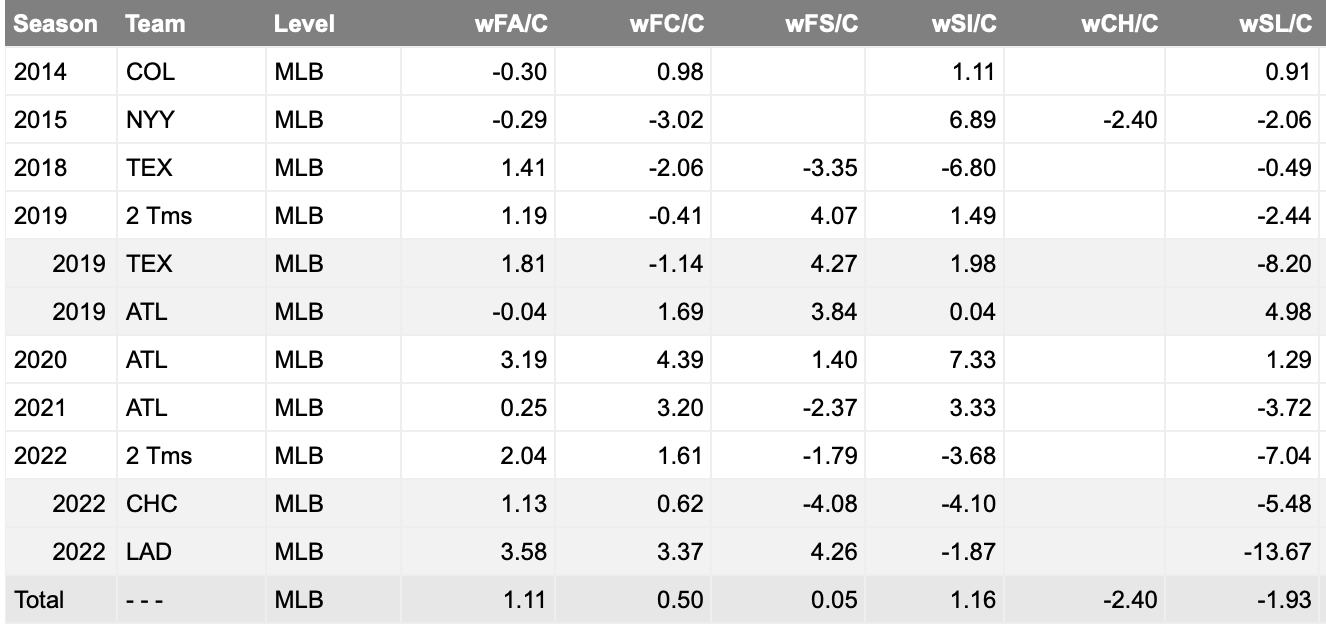Chris Martin was acquired three days prior to the deadline from the Cubs, and came to the Dodgers with a 4.31 ERA, a 1.34 WHIP, and a 40:4 strikeout to walk ratio across 31 innings. In typical Dodger fashion, Martin has excelled with his move out west, posting a 1.89 ERA, 0.53 WHIP with 23 strikeouts and no walks since switching to Dodger Blue.
Many Dodger fans remember Martin as the dominant Braves reliever who Cody Bellinger took deep in Game 7 of the 2020 NLCS to send the Dodgers to the World Series. And since that 2020 playoff run, Martin’s career has taken bit of a detour. He struggled the following year with the Braves before becoming a free agent and signing with the Cubs, where he continued to get hit around at a surprising rate.
Martin boasts a repertoire of a mid-90s fastball and a low-90s cutter that he pairs with a slider, splitter, and a sinker all sprinkled in. His velocity and movement have stayed consistent over the course of his career, so why the high fluctuation in results? Some of it can be attributed to the volatility that is inevitable with every relief pitcher. However, it seems that he’s really found something since coming over to the Dodgers.
——
At first glance, it doesn’t seem like Martin’s changed much. With such a quick turnaround, it’s unlikely the Dodgers had time to make any major mechanical adjustments, and there doesn’t seem to be any tinkering when scouring video of his outings. His K% and BB% are similar, suggesting that his stuff has been consistent, and instead the change seems to come in the form of pitch selection and location.
One thing that jumps out is Martin’s BABIP splits from his time with the Cubs and the Dodgers. Hitters had a .393 BABIP while Martin was in Chicago, but that number sits at .205 with L.A. Some of that can be attributed to luck and defense, but his average exit velocity and hard-hit rate are significantly lower now as well (LA: 85 MPH EV, 37% HardHit | CHI: 89 MPH, 45%).
Further analysis indicates that these numbers are a result of the type of contact Martin is inducing. His flyball percentage is up 16%, and the rate at which he induces infield popups is up 22%. Weak fly-balls almost always lead to outs and Martin is producing a lot more of them. Batters are also hitting his pitches to the opposite field 8% more since he joined the Dodgers.
Rather than any mechanical overhaul, the front office and Mark Prior likely just recognized that hitters do not pick up Martin’s fastballs well, and targeted him at the deadline because they identified an easy area of improvement. Over the course of Martin’s career, hitters have had much less success against his fastballs than any other pitch type. Here is a look at Martin’s career breakdown of pitch values over the course of his career:
While a lot of coverage of the adjustments the Dodgers make for pitchers has revolved around refining their slider, in this case instead of trying to fight against the grain and improve Martin’s slider, they have doubled down on the effectiveness of his fastballs and have called for them early and often.
Since his move to the Dodgers, Martin is throwing almost 10% more 4-seam fastballs and 4% more cutters while cutting back on his use of off-speed and breaking pitches by about 10%. In fact, the last time he even threw a slider was on September 1st against the Mets where it was hit 103 mph off the bat. Why throw something that is going to get hit hard if you don’t have to? He has since transitioned to using his cutter as his main “breaking ball”, and in his first full month with the team in August he set a career high for the percentage of cutters thrown at 35%.
Martin has especially used this pitch effectively to neutralize lefties, allowing an .846 OPS to them with the Cubs and just .296 with the Dodgers. Some of that is better luck, sure, but he also makes his own luck with the pitch by tripling his infield pop rate against lefties and allowing far weaker contact.
Location has also been something that has helped Martin keep balls off of the sweet spot of the bat. He has thrown more balls outside of the strike zone with the Dodgers, but the rate at which hitters are swinging at them has actually gone up 14%. This does not mean that he is producing a lot more swings and misses, however, as hitters are making contact with balls outside the zone 5% more, but that has contributed to the decrease in exit velocity and HardHit% allowed.
——
Time will tell if Chris Martin’s pitch selection continues to be this effective, as an issue pitchers can run into is the risk of becoming too predictable. So his other pitches will still be important to keep hitters honest, but it seems that the Dodgers are trying to capitalize on a strength to hide a weakness, which is working remarkably well so far.
With such a deep bullpen full of talented arms, the Dodgers should be able to deploy Martin in favorable high-leverage matchups where his heavy fastball usage will remain effective. And so far it sure looks like the Dodgers have found a successful reclamation project once again.
 Dodgers Digest Los Angeles Dodgers Baseball Blog
Dodgers Digest Los Angeles Dodgers Baseball Blog

